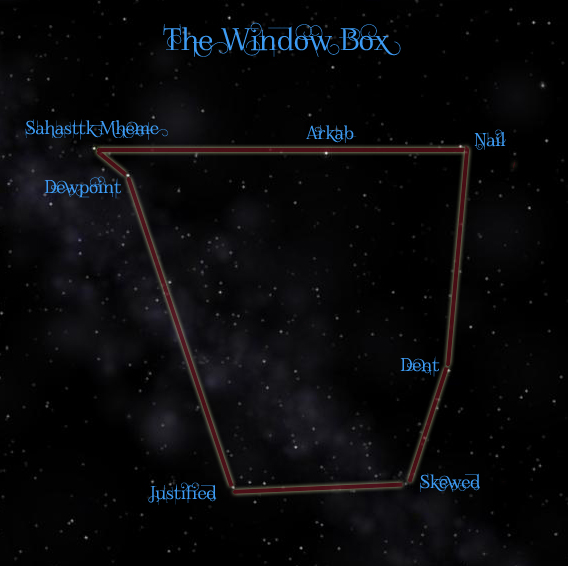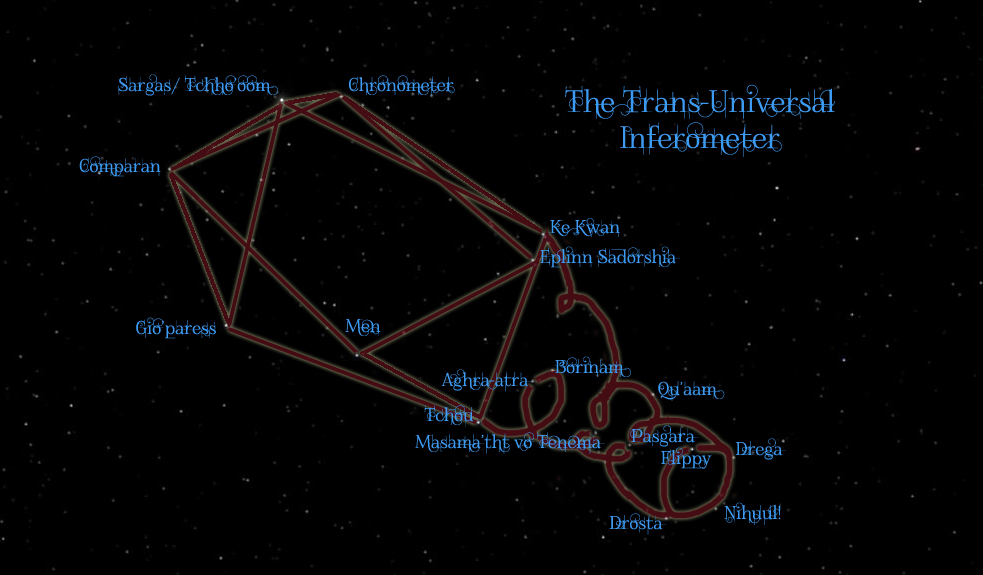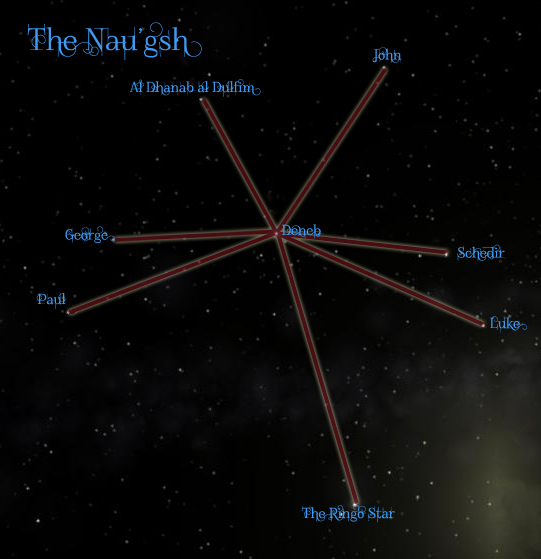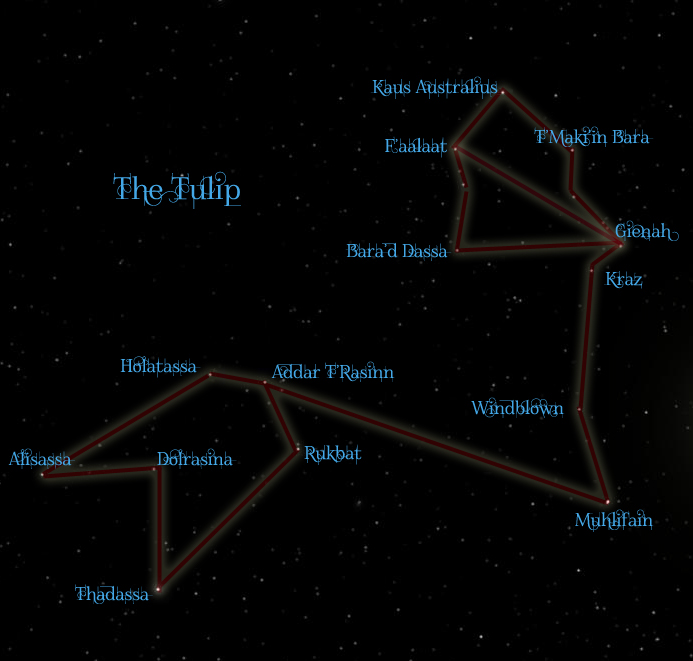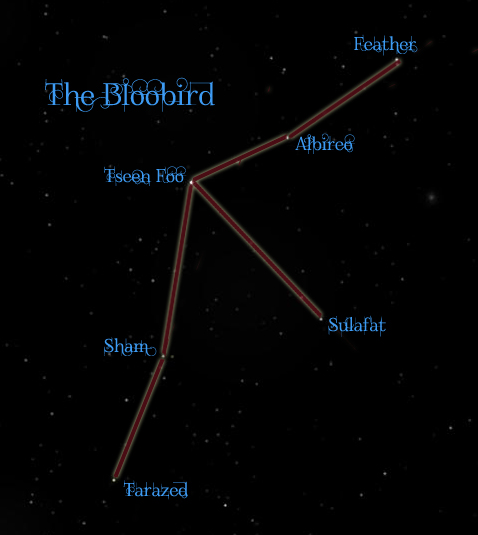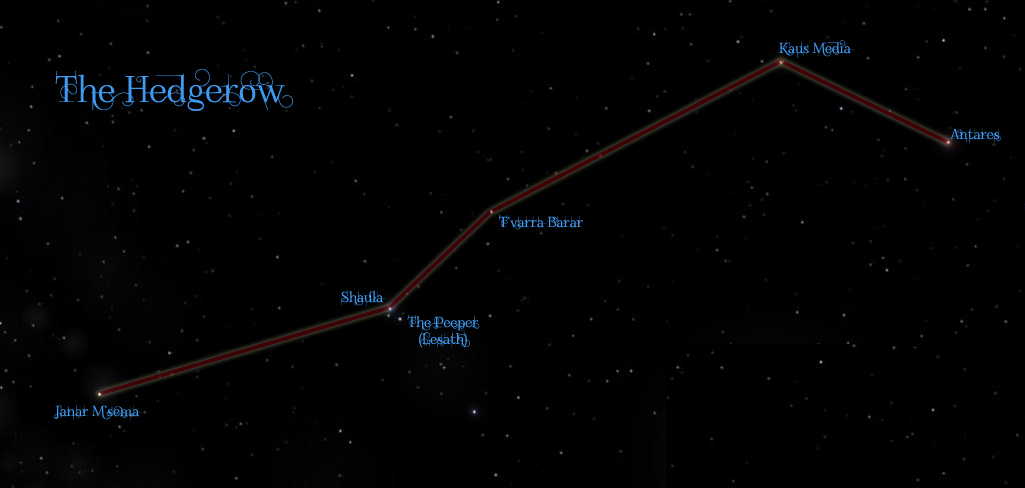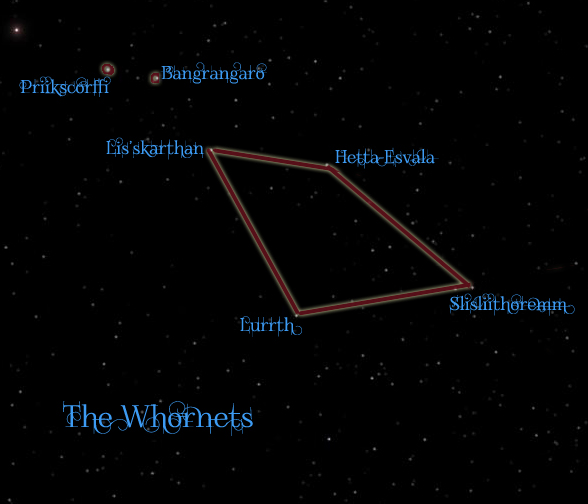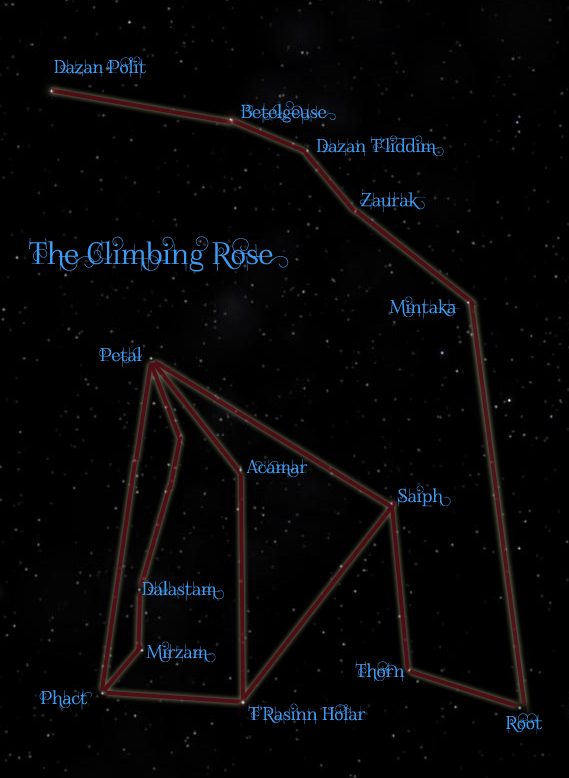When colonists from the Five Nations settled the Domha’vei system, their first concern was, of course, providing themselves with the necessities of life. This is why the system of Skarsian astrology is one of the first cultural productions of the Matriarchy. As the Skarsian year was, for convenience sake, broken into 12 months similar to the Terran year (although the length of the year is different, indeed changes for any planet in the Domha’vei), there are also twelve signs in the Skarsian Zodiac. The signs are determined by the entry of the sun into the constellation as perceived from Skarsia. Of course, the Domha’vei moves very little relative to the background of stars, and the phenomena we are describing is, in fact, the movement of the planet itself. Thus, it is very possible for the planet Volparnu to be in The Climbing Rose during the month of Stella, but it matters not one whit. This is not sidereal astrology; it isn’t meant to be logical.
The asterisms perceived by a society are fascinating glimpses into the thought and culture of those peoples. For example, Greco-Roman constellations are mainly figures from myth, Arabic astronomers saw human and animal figures, and the skies over China were filled with objects and buildings. How significant it is, therefore, that even before the settlement of Dolparessa, the Skarsian imagination was filled – one might say overgrown – with plants? Surely, the presence of the nau’gsh left an impression upon the archetypes, the etheric substratum of the unconscious minds of the colonists.
Over the course of a millennium, popular use has led the names of months, originally in Old Skarsian, to be given in Galactic Standard. However, the more obscure names of the stars (as is also true in Terran astronomy) have often retained their ancient names. For the convenience of the reader, I have listed the major stars in each constellation with their Terran designation and, if need be, translated a Skarsian name into Galactic Standard.
The Window Box:
Arkab β Sgr/A WB
Sahasttk Mheme (Light-catcher) β Ara/B WB
Nail ζ Ara/C WB
Dewpoint HIP 97749/D WB
Justified ξ Pav/E WB
Dent δ TrA/F WB
Skewed HIP 69763/G WB
The sun enters the constellation of the Window Box during the first month, Beginnings. This is seen as a time of preparation during the winter months. The window box is empty, but will soon be full of life. (Indeed, it is during the summer month of Sunstorm when the Window Box, now high in the Skarsian sky, is illuminated by the meteor shower known as the Boxuids.) Those born under the sign of the Window Box are seen as patient but firm. Lady Lorma is a denizen of the Window Box. This is one of the newer constellations as can be seen from the number of names in Galactic Standard. The A-star, Arkab, retains its traditional Terran name.
The Trans-Universal Inferometer:
Tchho’oom/Sargas (The power switch) θ Sco/A TI
Tchou α Ara/B TI
Gio’paress (Bifurcated Geometry) α Tel/C TI
Men α Lup/D TI
Chronometer γ Lup/E TI
Eplinn Sadorshia (Unexpected reading) β Lup/F TI
Drosta (Literally “The other side,” referring to the universe the inferometer is measuring) ζ Cen G TI
Flippy HIP 100224/H TI
Ke Kwan κ Cen/I TI
Comparan (Particle Composition Analysis) ε Lup/J TI
Aghra-atra (The tipping point) μ Cen/K TI
Qu’aam (The precise reading allowing an extrapolation to be made) ν Cen/L TI
Drega (Literally “This side” meaning Universe Prime) ι Lup/M TI
Masama’tht vo Tenema (A place of surprising vision) u1 Cen/N TI
Nihuul! (Danger of explosion) ρ Lup/ O TI
Borinam (The tip of the loop) (μ Lup/P TI
Pasgara (Holepuncher) HIP 95684/Q TI
The Domha’vei enters this constellation in the month of Fireside. It is an asterism created by the same sorts of imaginative astronomers who gave Earth’s skies “The Microscope” and “The Pump.” Fortunately, very few of these artificial names survived the early colonial years; this one probably lingered due to the evocative star names such as Masama’tht vo Tenema (“A place of surprising vision”) and Nihuul! (“Danger of explosion.”) A number of names – Tchou (“the pestle”), Men (“the south gate”) and Ke Kwan (“third star of imperial guards”) – are retained from Terran astronomy. Interestingly, the A-star, Tchho’oom, is one of the few stars that did not retain its Terran designation, probably because no one knows what the hell “Sargas” is supposed to mean.
The presence of this sign in one’s chart indicates the need for data-driven decision-making. Natives tend to be cautious but insightful. Nevertheless, they have moments of rash unpredictability (the temperamental contrast of the opposing sign, the Tulip – see below). Ta’al Erich was born under this sign.
Aureole:
The month of Matriarcha was originally dominated by an auspicious celestial configuration: the sun called the Domha’vei positioned perfectly against the background of the Lesser Magellanic Cloud. Historically, the 4th Matriarch’s ascension was planned during this phenomenon, and the constellations regularized around it accordingly. According to tradition, this was the time for prophecies of state, and indeed, the prophecy which predicted that Tara del D’myn would assume the Staff of the Matriarch was made during Aureole. Later astrologers, however, complained that Aureole was not a true constellation, and could never actually be viewed from the surface of Skarsia (the picture below was taken from orbit beyond the Skarsian atmosphere.) It was then replaced by the constellation known as the Nau’gsh although traditional Skarsian astrologers still refer to the ascension of Aureole.
The Nau’gsh:
The Ringo Star 17 Cap/A NG
Deneb α Cyg/B NG
Schedar α Cas/C NG
Al Dhanab al Dulfim ε Del/D NG
Luke ι Aql/E NG
Paul HIP 102891/F NG
George ζ Cyg/G NG
John HIP 101774/H NG
As can be inferred by its name, the Nau’gsh was a constellation created after the colonization of Dolparessa. Sadly, it lacks some of the evocative star names of earlier constellations, instead relying on the names of the then-popular saints of reform Mithraism: John, Paul, Luke, George and Ringo. A number of older Terran names are retained: Deneb, Schedir, Al Dhanab al Dulfim. Like Aureole before it, the constellation is taken as an indication that one is destined for greatness; popularly, it is supposed that those born under the Nau’gsh have a greater chance of attracting a Cu’enashti mate. Lady Premma has the Nau’gsh in her chart.
The Lillifers:
Nunki σ Sgr/A LF
Toom’esbeh (Firm Sepal) φ Sgr/B LF
Dschubba δ Sco/C LF
Va’atair’esbeh (Wobbly Sepal) ζ Oph/D LF
Graffias β Sco/E LF
Tuo’enprik (The Solemn Anther) χ Sgr/F LF
Misa-Rissa (Perfect Pistil) HIP 95865/G LF
Bulb HIP 95619/H LF
Pre’enprik (The Cheeky Anther) HIP 93498/I LF
Jabbah ν Sco/J LF
Appropriately, during the spring month of Blossoming, the Domha’vei enters the constellation of the Lillifers, one of the earliest-blooming plants of the season. As all gardening enthusiasts are aware, Lillifers are lovely but poisonous to touch. For this reason the constellation has a somewhat shady reputation. Lady Christolea and the 4th Matriarch were born under this sign, from which my gentle readers may draw their own conclusions. Nevertheless, this constellation has inspired one of the most delightful stellar myths, the courtship of Misa-Rissa (“perfect pistil”) of Toom’esbeh (“firm sepal”) by the Va’atair’esbeh (“wobbly sepal”) brothers Tuo’enprik (“solemn anther”) and Pre’enprik (“cheeky anther”). This is the origin of the traditional footraces where two athletes representing the brothers would vie for the crown of sepals. The winner was supposed to predict whether the upcoming season would be one of solemnity or mirth.
The Sprinkler:
Whst-wnd’lr (Wind-writer) ξ2 Sgr/A SP
Pure θ Oph/B SP
Tarma Zalit (Fluttering Rainbow) ψ Sgr/C SP
Cascade h1 Sgr/D SP
Pivot HIP 88839/E SP
Emola-edenn (Droplet – literally “water-seed”) 21 Sgr/F SP
Emola d’Hasla (The water-jet) 4 Sgr/G SP
Andsō (Gravitic Pull) c Oph/H SP
Quencher 14 Sgr/I SP
Terrans have a saying, “April showers bring May flowers.” Skarsians are less willing to leave such things to chance, and thus the fifth month, Stella, is heralded by the constellation called the Sprinkler. The stars of this constellation are all quite unremarkable from Earth, thus all of their names are of Skarsian origin. Sprinklers are in general considered to be all wet, and have their plans continually rained-upon. However, they are nurturing and bring very good fortune to their associates, so Sprinkler denizens are encouraged to seek out supporting roles. Sir Kaman Rafmin, the Tree Surgeon General, was born under the Sprinkler.
The Great Branch:
Canopus α Car/A GB
Rigel β Ori/B GB
Dh’hurr (The Bendy Bit) γ Mic/C GB
Al Dhanab γ Gru/D GB
K’halmait (The Bough) HIP 102014/E GB
Leaf θ Ori/F GB
This constellation is in the sky during the month of Nau’gshtide, arguably the most important month in the Skarsian calendar. It is the month of the Nau’gsh Festival, traditionally sacred to the Archon, marked with solemn ceremony on Skarsia and orgiastic reveling on Dolparessa (although of late, it has become a bit commercial.) Its A-star, Canopus, is the brightest star in the skies of the Domha’vei (and second-brightest in the Terran sky, even though Earth is 254 light-years away, which should give some indication of the size of Canopus.) This constellation is the sign of leaders and visionaries, those able to realize great plans and mutable enough to respond to circumstance. The Atlas Tree was planted under the sign of the Great Branch.
The Tulip:
Thadassa (The Drooping Petal) HIP 101469/A TU
Muhlifain γ Cen/B TU
Kaus Australis ε Sgr/C TU
Rukbat α Sgr/D TU
F’aalaat (The Vein) η Sgr/E TU
Alisassa (The Perky Petal) ζ CrA/F TU
Addar T’Rasinn (The place of flowering) δ CrA/G TU
Holatassa (Petal Begins) ε Crv/H TU
T’Maki’in Bara (The Crinkling Leaf) γ Sco/I TU
Gienah γ Crv/J TU
Kraz β Crv/K TU
Bara’d Dassa (Leaf’s Edge) ζ 2 Sco/L TU
Dolrasina (The Flower’s Heart) κ1 Lup/M TU
Windblown ζ Lup/N TU
Ironically, the Tulip, one of the most lovely and elaborate of the Skarsian constellations, is based upon a horticultural misunderstanding: Terran tulips are harbingers of spring, bursting forth from their bulbs and rarely blooming for more than a few weeks. This constellation, however, is present at midsummer, during the month of Sunstorm, and is rather a product of the nostalgia of early colonists for a dimly-remembered Earth. Many of the stars – Muhlifain, Kaus Australis, Rukbat, Gienah, Kraz – still bear their Terran appellations. Others carry the most beautiful of Skarsian titles: Addar T’Rasinn (“The place of flowering”), Dolrasina (“the flower’s heart”) and Windblown. Those born under the sign of the tulip are thought to be of whimsical temperament on the surface, but capable of blooming with remarkable consistency. Wyrd Elma is a Tulip.
The Bloobird:
Tseen Foo θ Aql A/B/A BB
Tarazed γ Aql/B BB
Feather ν Cap/C BB
Albireo β Cyg/D BB
Sulafat γ Lyr/E BB
Sham α Sge/F BB
Like its namesake, the Bloobird is a pastiche of Terran elements. The only star named by Skarsian astronomers is Feather, ironic since Dolparessan bloobirds have reptilian scales. Those born in the month of Starscape, under the bloobird, are thought to be fearsome individuals as the bloobird is only slightly less deadly than the rageraven, Dolparessa’s primary avian predator. Battlequeen Escharton is a notable Bloobird denizen.
The Hedgerow:
Antares α Sco/A HR
Shaula λ Sco/B HR
Kaus Media δ Sgr/C HR
Janar M’sema (The garden gate) HIP 9884/D HR
The Peeper/Lesath/ υ Sco/E HR
T’varra Barar (The Gathering of Leaves) HIP 98152/F HR
The Hedgerow stretches above the Skarsian sky in the month of Foundation. It is taken to be a sign of particularly good omen, as it was first observed when settlers made landfall on Skarsia. Hedgerow denizens are practical, straightforward and loyal. They are known for their protective nature. Lord Danak was born under the Hedgerow, but taken to the hospital soon after. Most of the star names are of Terran origin, but one, Lesath, is popularly known as “the Peeper through the Hedgerow.” In fact, the Peeper was on the horizon when Lord Danak was born, which explains a lot.
Moth:
Albaldah π Sgr/A MT
Fa’anlief (Leaf-wing) 60 Sgr/B MT
Domha’ab’hdas (Sun of the Heart) HIP 100947/C MT
Sedi-Sedi (Onomatopoeia for the sound of a flapping moth wing) c Sgr/D MT
Eddasoinne (Clouds made of stars) μ Sgr/E MT
Femfosheran (The Outstretched) 53 Sgr/F MT
Domha’Rasinn (Sun of Flowering) HIP 96496/G MT
Eldopleth (Cocoon-silk) HIP 93667/H MT
Amberson (named after Kaula Amberson, an explorer) u/46 Sgr/I MT
Slushtoka (Moth-derriere) HIP 88060/J MT
Gorevan-Herith (Lovely in Silence) HIP 92635/K MT
Before 3599, the 10th month of the year was known as Sunslip. It was changed to Restoration, to celebrate the Restoration of the Archonate, and as every Skarsian knows, the great Enlightenment Festival begins on Restoration Day, which is celebrated on the first Archonsday of that month. The festival celebrates the restoration of the power grid to the worlds (literally enlightenment) upon the sincere remorse of the people (caused, no doubt by the pervasive system-wide power outage) at the way they had treated the Archon and the Matriarch, and their subsequent enlightenment that no Archon = no power, which would result in the deaths of millions. Yes, it is a joyous season (well, not all of the Archons agree that it is really worth the bother, but Aran is probably in a bad mood caused by having to wear his ceremonial robes of magenta silk and snow emu feathers). In any case, those born under the sign of Moth are considered truly gifted, visionaries, artists and writers.
The Whornets:
Priikscorffi (Anther-sniffer (one of the whornets)) τ Sco/A WN
Bangrangaro (Little Buzzy (one of the whornets)) π Sco/B WN
Hetta-Esvala (Necessary for spring) ρ Sco/C WN
Slisliithoremm (Small, Dangerous Things) HIP 81304/D WN
Lis’skarthan (Dark doorway) HIP 90763/E WN
Lurrth (Soft corner (of the nest)) HIP 90124/F WN
Historically, the month of Novemberoon has always been a bother: falling leaves (although not on Dolparessa, since Cu’endhari would never be so gauche as to strip in public), chilly weather, and political plotting, such as the infamous Novemberoon Rebellion led by Guinnebar the Pretender. The month is marked by bonfires where, traditionally, straw men filled with leaves are burned. Nobody really remembers why it is done – probably out of frustration with the weather – but it is certainly a morbid custom!
Therefore, what better constellation to represent this dire season than the Whornets? It is just the season where the nasty little buggers move indoors, chewing through the concrete and secreting their masonic nests, so difficult to remove without damaging the building. The folktale surrounding the constellation is, however, somewhat amusing, and so I shall recount it here. Two of the whornets, Priikscorffi (“anther-sniffer”) and Bangrangaro (“little buzzy”) decide that the nectar stored for the winter isn’t good enough for them, so they decide to look for fresh nectar. However, the only flowers putting out fresh nectar at this time of year are common nau’gsh trees. Nau’gsh nectar is an intoxicant to whornets, and so the pair become so sotted that they confuse a Cu’enashti nau’gsh for a common nau’gsh, and…ah, I suppose that the story gets a bit too ribald for a general audience, but trust me, it’s hilarious. Those born under the Whornets are in trouble.
The Climbing Rose:
Betelgeuse α Ori/A CR
T’Rasinn Holar (Flowering begins) β Gru/B CR
Dazan Polit (The creeper’s tip) HIP 102581/C CR
Saiph κ Ori/D CR
Mirzam/Murzim β CMa/E CR
Root β Phe/F CR
Phact α Col/G CR
Acamar θ Eri/H CR
Petal HIP 104298/I CR
Thorn ι Gru/J CR
Mintaka δ Ori/K CR
Dazan T’liddim (Wrapping creeper) δ PsA/L CR
Zaurak γ Eri/M CR
Dalastam (Secret Place) ψ Eri/N CR12.
The final constellation of the series is, in my opinion, the most lovely: the Climbing Rose. It serves as a reminder that beauty persists, even in the harsh coldness of the month of Windwhippit. The names of the stars are poetry in themselves: T’Rasinn Holar (“Flowering begins”), Dalastam (“Secret place”), or even the simply named Root and Petal. Climbing Rose denizens are the loftiest of the signs, ambitious, talented and attractive, although some say of prickly temperament. It is also a sign of great military commanders, and auspicious for victory in battle. The 6th Matriarch was born under this sign, which has in no way affected my judgement.
Thanks to Meighan Chimera for preparing the starmaps – she used Celestia, free software released under the GNU General Public License v.2. The overlay of asterisms and star names was done by Archbishop Seth.



